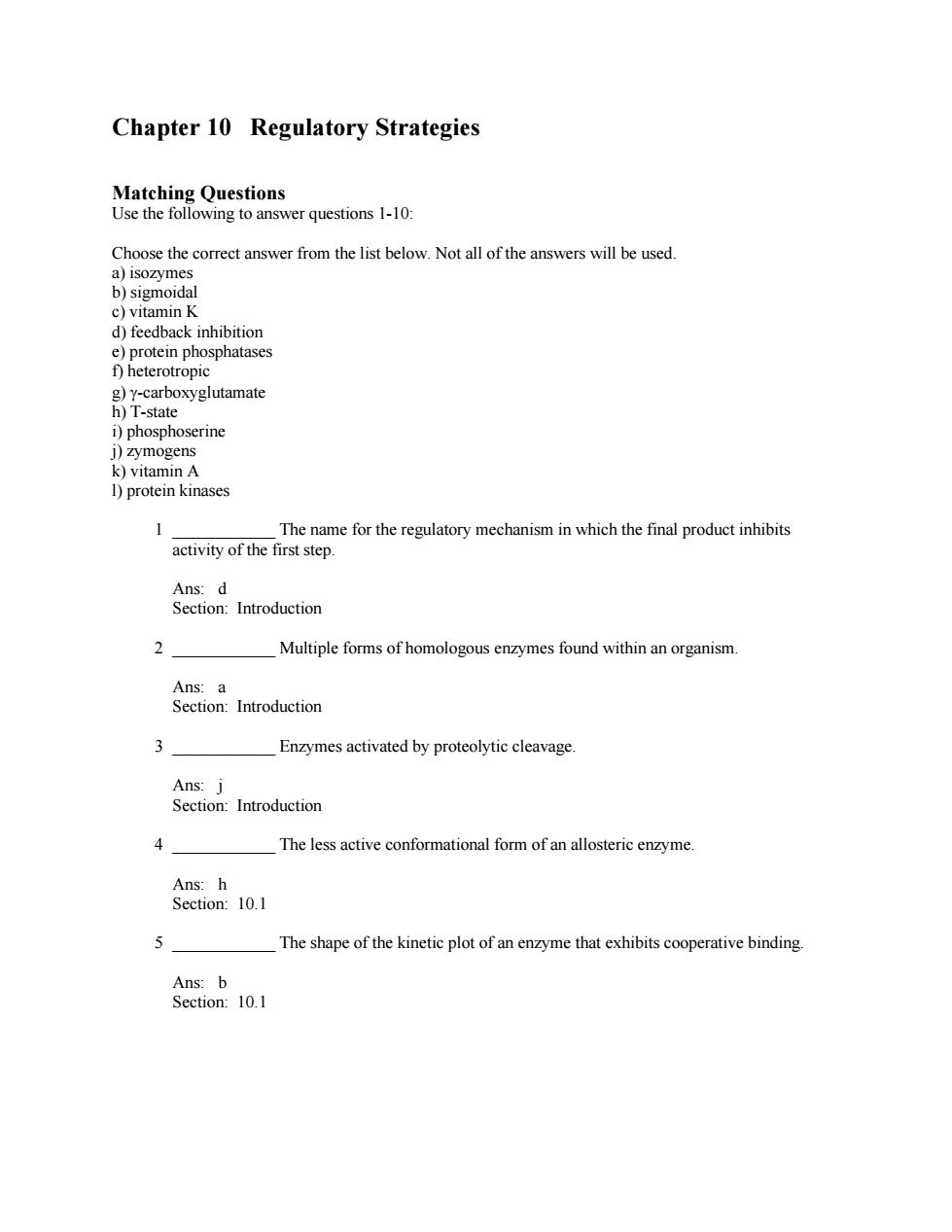
Chapter 10 Regulatory Strategies Matching Questions Use the following to answer questions 1-10: Choose the correct answer from the list below.Not all of the answers will be used. a)isozymes b)sigmoidal c)vitamin K d)feedback inhibition e)protein phosphatases f)heterotropic g)y-carboxyglutamate h)T-state i)phosphoserine j)zymogens k)vitamin A 1)protein kinases The name for the regulatory mechanism in which the final product inhibits activity of the first step. Ans:d Section:Introduction Multiple forms of homologous enzymes found within an organism Ans:a Section:Introduction 3 Enzymes activated by proteolytic cleavage. Ans:j Section:Introduction 4 The less active conformational form of an allosteric enzyme Ans:h Section:10.1 5 The shape of the kinetic plot of an enzyme that exhibits cooperative binding. Ans:b Section:10.1
Chapter 10 Regulatory Strategies Matching Questions Use the following to answer questions 1-10: Choose the correct answer from the list below. Not all of the answers will be used. a) isozymes b) sigmoidal c) vitamin K d) feedback inhibition e) protein phosphatases f) heterotropic g) -carboxyglutamate h) T-state i) phosphoserine j) zymogens k) vitamin A l) protein kinases 1 ____________ The name for the regulatory mechanism in which the final product inhibits activity of the first step. Ans: d Section: Introduction 2 ____________ Multiple forms of homologous enzymes found within an organism. Ans: a Section: Introduction 3 ____________ Enzymes activated by proteolytic cleavage. Ans: j Section: Introduction 4 ____________ The less active conformational form of an allosteric enzyme. Ans: h Section: 10.1 5 ____________ The shape of the kinetic plot of an enzyme that exhibits cooperative binding. Ans: b Section: 10.1
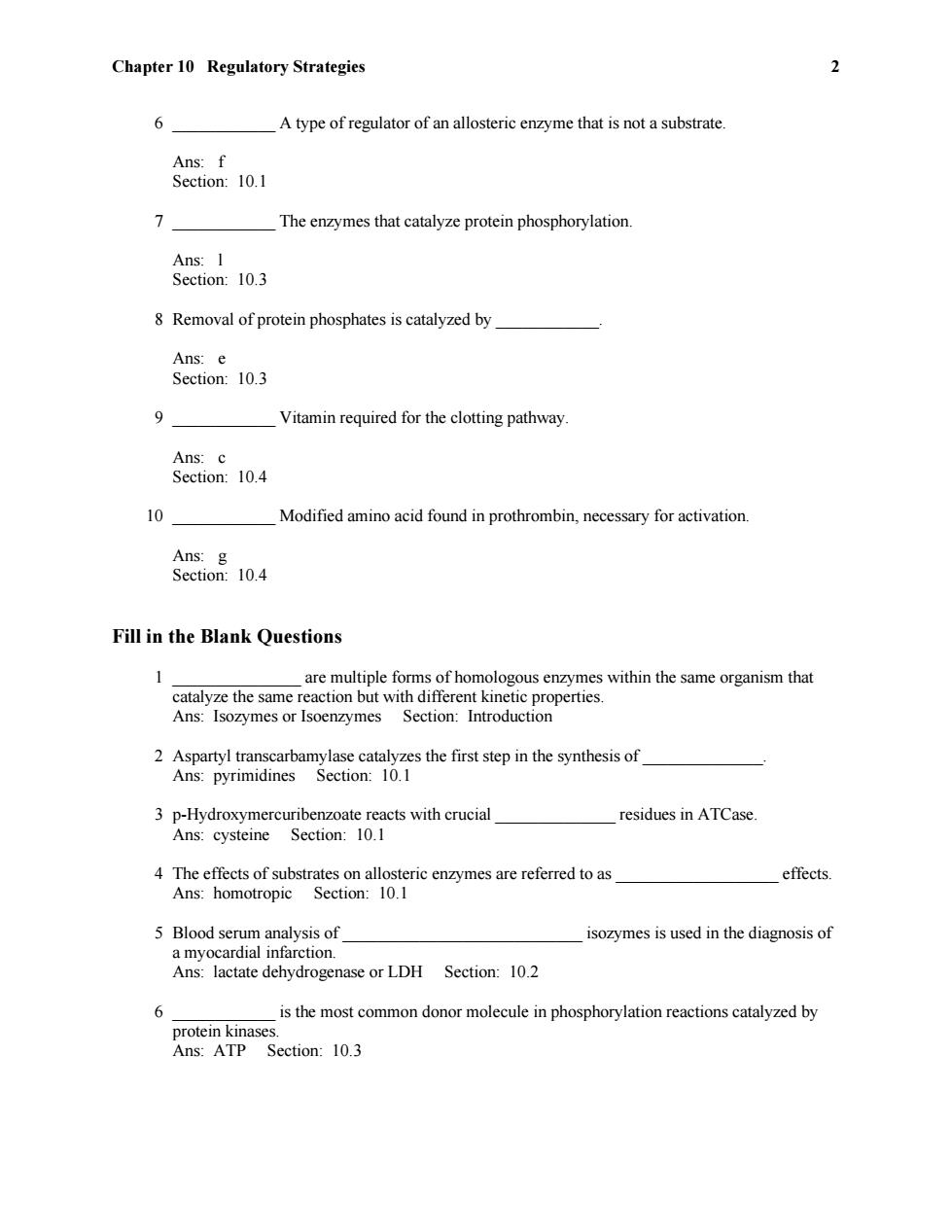
Chapter 10 Regulatory Strategies 2 6 A type of regulator of an allosteric enzyme that is not a substrate. Ans:f Section:10.1 7 The enzymes that catalyze protein phosphorylation Ans:I Section:10.3 8 Removal of protein phosphates is catalyzed by Ans:e Section:10.3 9 Vitamin required for the clotting pathway. Ans:c Section:10.4 10 Modified amino acid found in prothrombin,necessary for activation Ans:g Section:10.4 Fill in the Blank Questions 1 are multiple forms of homologous enzymes within the same organism that catalyze the same reaction but with different kinetic properties. Ans:Isozymes or Isoenzymes Section:Introduction 2 Aspartyl transcarbamylase catalyzes the first step in the synthesis of Ans:pyrimidines Section:10.1 3 p-Hydroxymercuribenzoate reacts with crucial residues in ATCase. Ans:cysteine Section:10.1 4 The effects of substrates on allosteric enzymes are referred to as effects. Ans:homotropic Section:10.1 5 Blood serum analysis of isozymes is used in the diagnosis of a myocardial infarction. Ans:lactate dehydrogenase or LDH Section:10.2 6 is the most common donor molecule in phosphorylation reactions catalyzed by protein kinases. Ans:ATP Section:10.3
Chapter 10 Regulatory Strategies 2 6 ____________ A type of regulator of an allosteric enzyme that is not a substrate. Ans: f Section: 10.1 7 ____________ The enzymes that catalyze protein phosphorylation. Ans: l Section: 10.3 8 Removal of protein phosphates is catalyzed by ____________. Ans: e Section: 10.3 9 ____________ Vitamin required for the clotting pathway. Ans: c Section: 10.4 10 ____________ Modified amino acid found in prothrombin, necessary for activation. Ans: g Section: 10.4 Fill in the Blank Questions 1 _______________ are multiple forms of homologous enzymes within the same organism that catalyze the same reaction but with different kinetic properties. Ans: Isozymes or Isoenzymes Section: Introduction 2 Aspartyl transcarbamylase catalyzes the first step in the synthesis of ______________. Ans: pyrimidines Section: 10.1 3 p-Hydroxymercuribenzoate reacts with crucial ______________ residues in ATCase. Ans: cysteine Section: 10.1 4 The effects of substrates on allosteric enzymes are referred to as ___________________ effects. Ans: homotropic Section: 10.1 5 Blood serum analysis of ____________________________ isozymes is used in the diagnosis of a myocardial infarction. Ans: lactate dehydrogenase or LDH Section: 10.2 6 ____________ is the most common donor molecule in phosphorylation reactions catalyzed by protein kinases. Ans: ATP Section: 10.3

Chapter 10 Regulatory Strategies 3 7 Histones are acetylated at specific residues. Ans:lysine Section:10.3 8 Protein kinases add phosphoryl groups to serine,threonine,and residues in target proteins. Ans:tyrosine Section:10.3 9 Protein kinase A is activated by binding to specific sites on the regulatory subunit. Ans:c-AMP Section:10.3 10A is an inactive precursor of an enzyme that is activated by a proteolytic cleavage. Ans:zymogen Section:10.4 Multiple Choice Questions 1 The most common strategy(ies)for enzymatic regulation: A) multiple enzyme forms D) proteolytic activation B) allosteric control E) All of the above C) reversible covalent modification Ans:E Section:Introduction 2 Allosteric proteins A) contain distinct regulatory sites and have multiple functional sites. B) display cooperativity C) always consist of several identical subunits D) a and b E)a,b,and c Ans:D Section:Introduction 3 Many allosteric enzymes have two types of subunits,termed A) catalytic and regulatory. D All of the above. B) regulatory and allosteric. E) None of the above. C)allosteric and regulatory Ans:A Section:10.1 4 Changes in ATCase conformation were detected by crystallizing the enzyme in the presence of PALA (N-(phosphonacetyl)-L-aspartate).What is PALA? A)a radioactive tag that binds to the subunits B)a bi-substrate analog that resembles the catalytic transition-state intermediate C)a fluorescent substrate analog D)All of the above. E)None of the above Ans:B Section:10.1 5 The relaxed form of an allosteric enzyme has affinity for the substrates. A)higher B)equal C)lower D)no E)None of the above. Ans:A Section:10.1
Chapter 10 Regulatory Strategies 3 7 Histones are acetylated at specific ________________ residues. Ans: lysine Section: 10.3 8 Protein kinases add phosphoryl groups to serine, threonine, and _________________ residues in target proteins. Ans: tyrosine Section: 10.3 9 Protein kinase A is activated by binding ________________ to specific sites on the regulatory subunit. Ans: c-AMP Section: 10.3 10 A ______________ is an inactive precursor of an enzyme that is activated by a proteolytic cleavage. Ans: zymogen Section: 10.4 Multiple Choice Questions 1 The most common strategy(ies) for enzymatic regulation: A) multiple enzyme forms D) proteolytic activation B) allosteric control E) All of the above. C) reversible covalent modification Ans: E Section: Introduction 2 Allosteric proteins A) contain distinct regulatory sites and have multiple functional sites. B) display cooperativity. C) always consist of several identical subunits. D) a and b E) a, b, and c Ans: D Section: Introduction 3 Many allosteric enzymes have two types of subunits, termed A) catalytic and regulatory. D) All of the above. B) regulatory and allosteric. E) None of the above. C) allosteric and regulatory. Ans: A Section: 10.1 4 Changes in ATCase conformation were detected by crystallizing the enzyme in the presence of PALA (N-(phosphonacetyl)-L-aspartate). What is PALA? A) a radioactive tag that binds to the subunits B) a bi-substrate analog that resembles the catalytic transition-state intermediate C) a fluorescent substrate analog D) All of the above. E) None of the above. Ans: B Section: 10.1 5 The relaxed form of an allosteric enzyme has _________ affinity for the substrates. A) higher B) equal C) lower D) no E) None of the above. Ans: A Section: 10.1
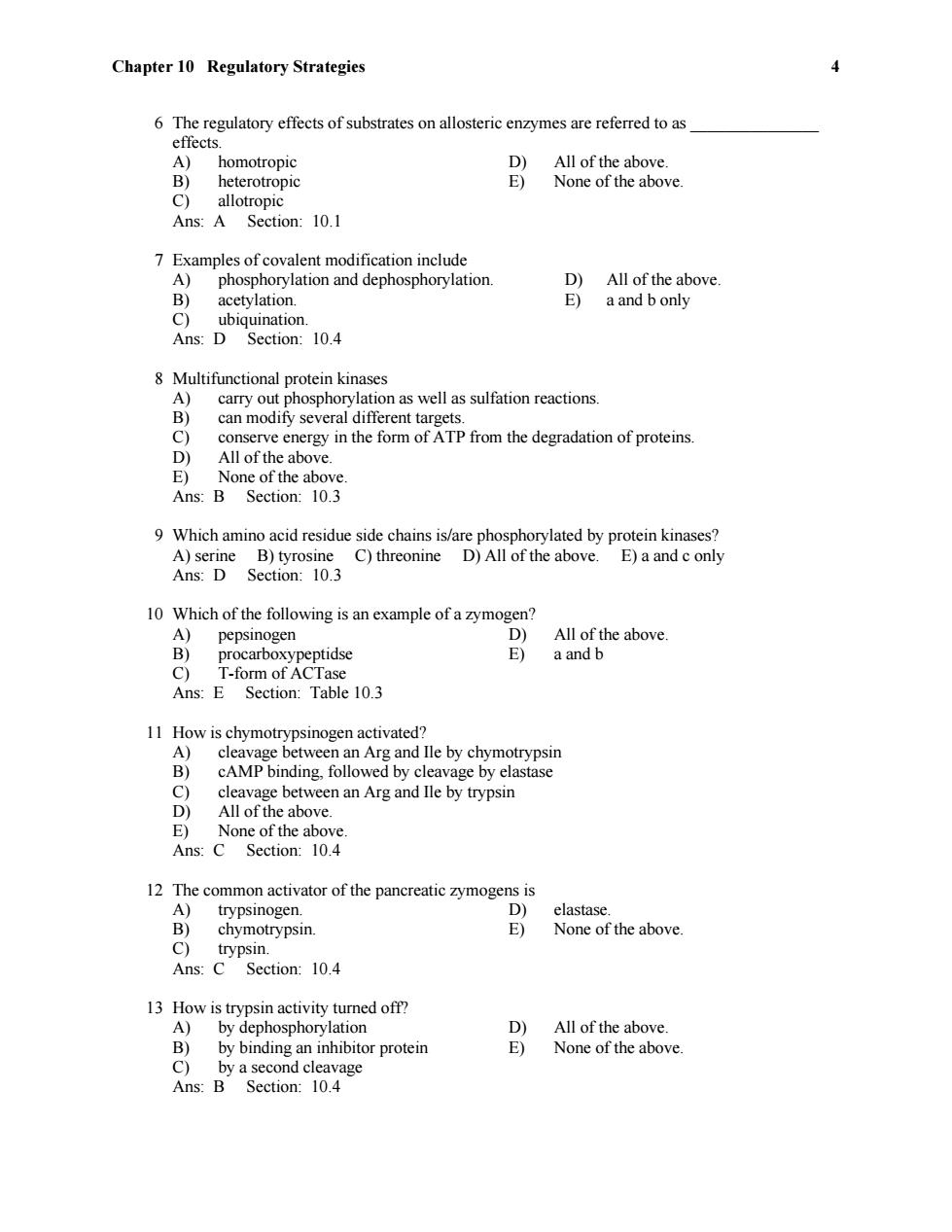
Chapter 10 Regulatory Strategies 4 6 The regulatory effects of substrates on allosteric enzymes are referred to as effects. A) homotropic D) All of the above. B) heterotropic E) None of the above. C) allotropic Ans:A Section:10.1 7 Examples of covalent modification include A) phosphorylation and dephosphorylation. D) All of the above. B) acetylation. E) a and b only C) ubiquination Ans:D Section:10.4 8 Multifunctional protein kinases A) carry out phosphorylation as well as sulfation reactions B) can modify several different targets. C) conserve energy in the form of ATP from the degradation of proteins. D) All of the above. E) None of the above. Ans:B Section:10.3 9 Which amino acid residue side chains is/are phosphorylated by protein kinases? A)serine B)tyrosine C)threonine D)All of the above.E)a and c only Ans:D Section:10.3 10 Which of the following is an example of a zymogen? A) pepsinogen D All of the above. B) procarboxypeptidse E) a and b C) T-form of ACTase Ans:E Section:Table 103 11 How is chymotrypsinogen activated? A) cleavage between an Arg and Ile by chymotrypsin B) cAMP binding,followed by cleavage by elastase C) cleavage between an Arg and Ile by trypsin D) All of the above. E) None of the above. Ans:C Section:10.4 12 The common activator of the pancreatic zymogens is A)trypsinogen. D) elastase B) chymotrypsin E) None of the above. C) trypsin Ans:C Section:10.4 13 How is trypsin activity turned off? A)by dephosphorylation D All of the above. B)by binding an inhibitor protein E) None of the above C)by a second cleavage Ans:B Section:10.4
Chapter 10 Regulatory Strategies 4 6 The regulatory effects of substrates on allosteric enzymes are referred to as _______________ effects. A) homotropic D) All of the above. B) heterotropic E) None of the above. C) allotropic Ans: A Section: 10.1 7 Examples of covalent modification include A) phosphorylation and dephosphorylation. D) All of the above. B) acetylation. E) a and b only C) ubiquination. Ans: D Section: 10.4 8 Multifunctional protein kinases A) carry out phosphorylation as well as sulfation reactions. B) can modify several different targets. C) conserve energy in the form of ATP from the degradation of proteins. D) All of the above. E) None of the above. Ans: B Section: 10.3 9 Which amino acid residue side chains is/are phosphorylated by protein kinases? A) serine B) tyrosine C) threonine D) All of the above. E) a and c only Ans: D Section: 10.3 10 Which of the following is an example of a zymogen? A) pepsinogen D) All of the above. B) procarboxypeptidse E) a and b C) T-form of ACTase Ans: E Section: Table 10.3 11 How is chymotrypsinogen activated? A) cleavage between an Arg and Ile by chymotrypsin B) cAMP binding, followed by cleavage by elastase C) cleavage between an Arg and Ile by trypsin D) All of the above. E) None of the above. Ans: C Section: 10.4 12 The common activator of the pancreatic zymogens is A) trypsinogen. D) elastase. B) chymotrypsin. E) None of the above. C) trypsin. Ans: C Section: 10.4 13 How is trypsin activity turned off? A) by dephosphorylation D) All of the above. B) by binding an inhibitor protein E) None of the above. C) by a second cleavage Ans: B Section: 10.4
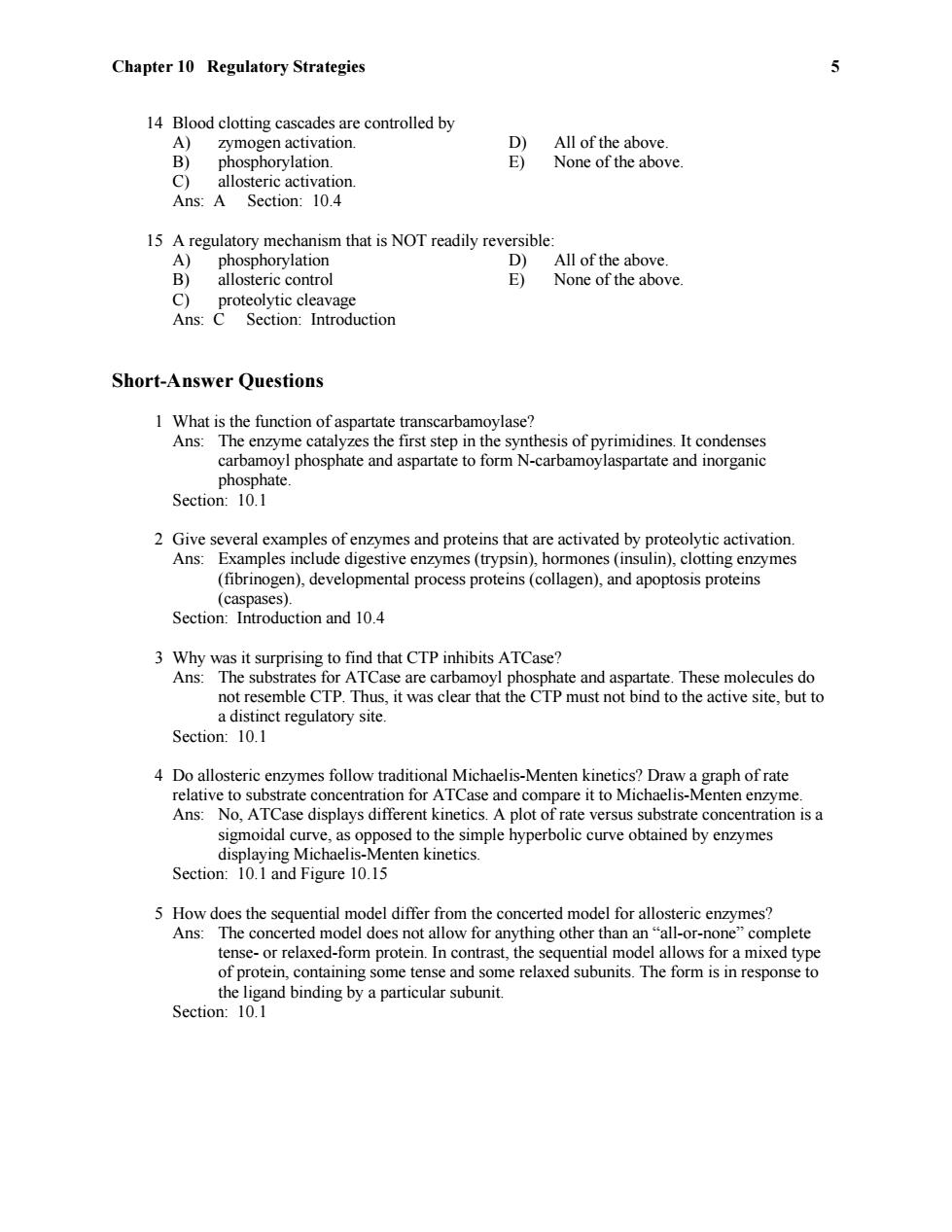
Chapter 10 Regulatory Strategies 14 Blood clotting cascades are controlled by A) zymogen activation. D) All of the above. B) phosphorylation. E) None of the above. C) allosteric activation Ans:A Section:10.4 15 A regulatory mechanism that is NOT readily reversible: A) phosphorylation D) All of the above. B) allosteric control E) None of the above. C) proteolytic cleavage Ans:C Section:Introduction Short-Answer Questions 1 What is the function of aspartate transcarbamoylase? Ans:The enzyme catalyzes the first step in the synthesis of pyrimidines.It condenses carbamoyl phosphate and aspartate to form N-carbamoylaspartate and inorganic phosphate. Section:10.1 2 Give several examples of enzymes and proteins that are activated by proteolytic activation. Ans:Examples include digestive enzymes (trypsin),hormones(insulin),clotting enzymes (fibrinogen),developmental process proteins(collagen),and apoptosis proteins (caspases). Section:Introduction and 10.4 3 Why was it surprising to find that CTP inhibits ATCase? Ans:The substrates for ATCase are carbamoyl phosphate and aspartate.These molecules do not resemble CTP.Thus,it was clear that the CTP must not bind to the active site,but to a distinct regulatory site. Section:10.1 4 Do allosteric enzymes follow traditional Michaelis-Menten kinetics?Draw a graph of rate relative to substrate concentration for ATCase and compare it to Michaelis-Menten enzyme. Ans:No,ATCase displays different kinetics.A plot of rate versus substrate concentration is a sigmoidal curve,as opposed to the simple hyperbolic curve obtained by enzymes displaying Michaelis-Menten kinetics. Section:10.1 and Figure 10.15 5 How does the sequential model differ from the concerted model for allosteric enzymes? Ans:The concerted model does not allow for anything other than an"all-or-none"complete tense-or relaxed-form protein.In contrast,the sequential model allows for a mixed type of protein,containing some tense and some relaxed subunits.The form is in response to the ligand binding by a particular subunit. Section:10.1
Chapter 10 Regulatory Strategies 5 14 Blood clotting cascades are controlled by A) zymogen activation. D) All of the above. B) phosphorylation. E) None of the above. C) allosteric activation. Ans: A Section: 10.4 15 A regulatory mechanism that is NOT readily reversible: A) phosphorylation D) All of the above. B) allosteric control E) None of the above. C) proteolytic cleavage Ans: C Section: Introduction Short-Answer Questions 1 What is the function of aspartate transcarbamoylase? Ans: The enzyme catalyzes the first step in the synthesis of pyrimidines. It condenses carbamoyl phosphate and aspartate to form N-carbamoylaspartate and inorganic phosphate. Section: 10.1 2 Give several examples of enzymes and proteins that are activated by proteolytic activation. Ans: Examples include digestive enzymes (trypsin), hormones (insulin), clotting enzymes (fibrinogen), developmental process proteins (collagen), and apoptosis proteins (caspases). Section: Introduction and 10.4 3 Why was it surprising to find that CTP inhibits ATCase? Ans: The substrates for ATCase are carbamoyl phosphate and aspartate. These molecules do not resemble CTP. Thus, it was clear that the CTP must not bind to the active site, but to a distinct regulatory site. Section: 10.1 4 Do allosteric enzymes follow traditional Michaelis-Menten kinetics? Draw a graph of rate relative to substrate concentration for ATCase and compare it to Michaelis-Menten enzyme. Ans: No, ATCase displays different kinetics. A plot of rate versus substrate concentration is a sigmoidal curve, as opposed to the simple hyperbolic curve obtained by enzymes displaying Michaelis-Menten kinetics. Section: 10.1 and Figure 10.15 5 How does the sequential model differ from the concerted model for allosteric enzymes? Ans: The concerted model does not allow for anything other than an “all-or-none” complete tense- or relaxed-form protein. In contrast, the sequential model allows for a mixed type of protein, containing some tense and some relaxed subunits. The form is in response to the ligand binding by a particular subunit. Section: 10.1
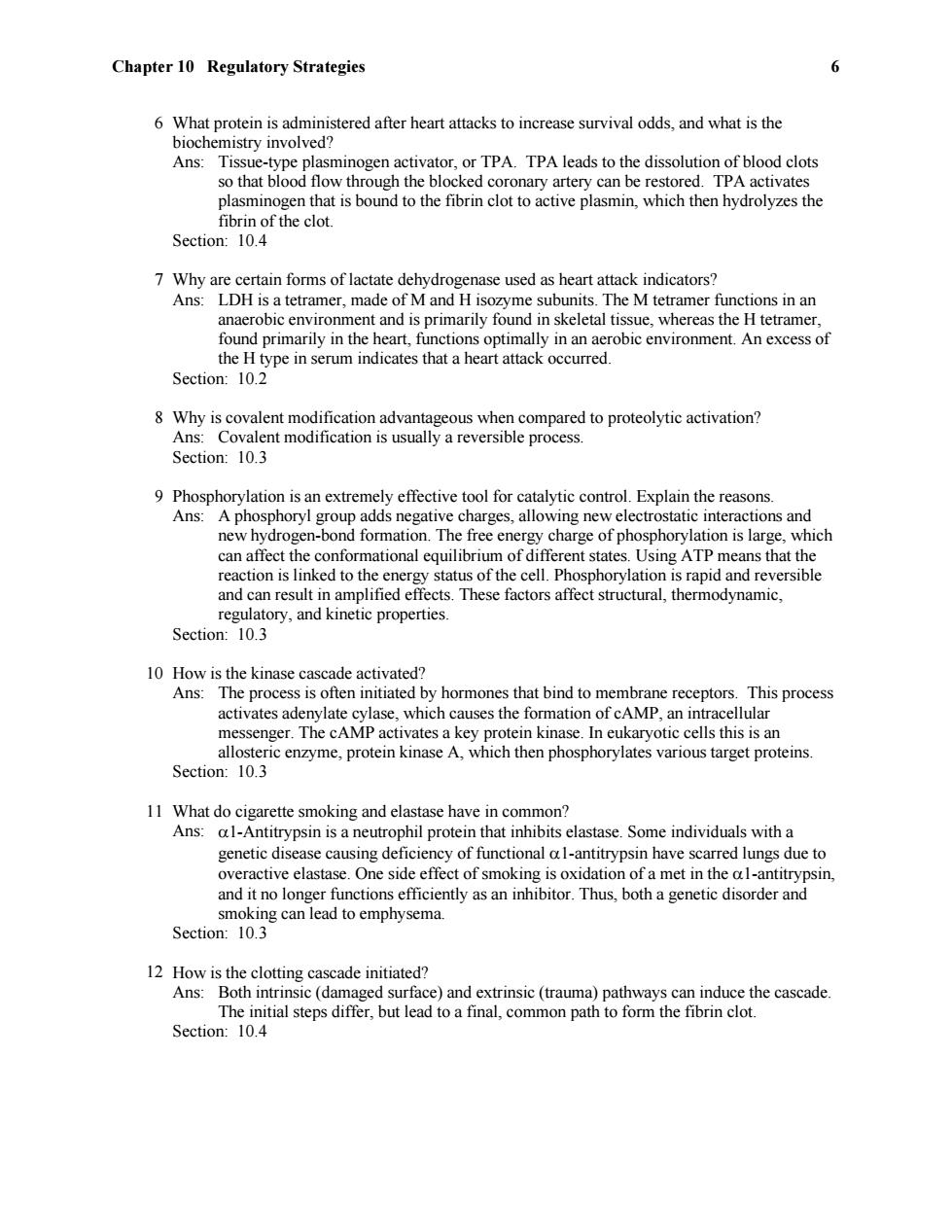
Chapter 10 Regulatory Strategies 6 6 What protein is administered after heart attacks to increase survival odds,and what is the biochemistry involved? Ans:Tissue-type plasminogen activator,or TPA.TPA leads to the dissolution of blood clots so that blood flow through the blocked coronary artery can be restored.TPA activates plasminogen that is bound to the fibrin clot to active plasmin,which then hydrolyzes the fibrin of the clot. Section:10.4 7 Why are certain forms of lactate dehydrogenase used as heart attack indicators? Ans:LDH is a tetramer,made of M and H isozyme subunits.The M tetramer functions in an anaerobic environment and is primarily found in skeletal tissue,whereas the H tetramer, found primarily in the heart,functions optimally in an aerobic environment.An excess of the H type in serum indicates that a heart attack occurred. Section:10.2 8 Why is covalent modification advantageous when compared to proteolytic activation? Ans:Covalent modification is usually a reversible process. Section:10.3 9 Phosphorylation is an extremely effective tool for catalytic control.Explain the reasons. Ans:A phosphoryl group adds negative charges,allowing new electrostatic interactions and new hydrogen-bond formation.The free energy charge of phosphorylation is large,which can affect the conformational equilibrium of different states.Using ATP means that the reaction is linked to the energy status of the cell.Phosphorylation is rapid and reversible and can result in amplified effects.These factors affect structural,thermodynamic, regulatory,and kinetic properties. Section:10.3 10 How is the kinase cascade activated? Ans:The process is often initiated by hormones that bind to membrane receptors.This process activates adenylate cylase,which causes the formation of cAMP,an intracellular messenger.The cAMP activates a key protein kinase.In eukaryotic cells this is an allosteric enzyme,protein kinase A,which then phosphorylates various target proteins. Section:10.3 11 What do cigarette smoking and elastase have in common? Ans:a1-Antitrypsin is a neutrophil protein that inhibits elastase.Some individuals with a genetic disease causing deficiency of functional a l-antitrypsin have scarred lungs due to overactive elastase.One side effect of smoking is oxidation of a met in the al-antitrypsin, and it no longer functions efficiently as an inhibitor.Thus,both a genetic disorder and smoking can lead to emphysema. Section:10.3 12 How is the clotting cascade initiated? Ans:Both intrinsic(damaged surface)and extrinsic(trauma)pathways can induce the cascade The initial steps differ,but lead to a final,common path to form the fibrin clot. Section:10.4
Chapter 10 Regulatory Strategies 6 6 What protein is administered after heart attacks to increase survival odds, and what is the biochemistry involved? Ans: Tissue-type plasminogen activator, or TPA. TPA leads to the dissolution of blood clots so that blood flow through the blocked coronary artery can be restored. TPA activates plasminogen that is bound to the fibrin clot to active plasmin, which then hydrolyzes the fibrin of the clot. Section: 10.4 7 Why are certain forms of lactate dehydrogenase used as heart attack indicators? Ans: LDH is a tetramer, made of M and H isozyme subunits. The M tetramer functions in an anaerobic environment and is primarily found in skeletal tissue, whereas the H tetramer, found primarily in the heart, functions optimally in an aerobic environment. An excess of the H type in serum indicates that a heart attack occurred. Section: 10.2 8 Why is covalent modification advantageous when compared to proteolytic activation? Ans: Covalent modification is usually a reversible process. Section: 10.3 9 Phosphorylation is an extremely effective tool for catalytic control. Explain the reasons. Ans: A phosphoryl group adds negative charges, allowing new electrostatic interactions and new hydrogen-bond formation. The free energy charge of phosphorylation is large, which can affect the conformational equilibrium of different states. Using ATP means that the reaction is linked to the energy status of the cell. Phosphorylation is rapid and reversible and can result in amplified effects. These factors affect structural, thermodynamic, regulatory, and kinetic properties. Section: 10.3 10 How is the kinase cascade activated? Ans: The process is often initiated by hormones that bind to membrane receptors. This process activates adenylate cylase, which causes the formation of cAMP, an intracellular messenger. The cAMP activates a key protein kinase. In eukaryotic cells this is an allosteric enzyme, protein kinase A, which then phosphorylates various target proteins. Section: 10.3 11 What do cigarette smoking and elastase have in common? Ans: 1-Antitrypsin is a neutrophil protein that inhibits elastase. Some individuals with a genetic disease causing deficiency of functional 1-antitrypsin have scarred lungs due to overactive elastase. One side effect of smoking is oxidation of a met in the 1-antitrypsin, and it no longer functions efficiently as an inhibitor. Thus, both a genetic disorder and smoking can lead to emphysema. Section: 10.3 12 How is the clotting cascade initiated? Ans: Both intrinsic (damaged surface) and extrinsic (trauma) pathways can induce the cascade. The initial steps differ, but lead to a final, common path to form the fibrin clot. Section: 10.4
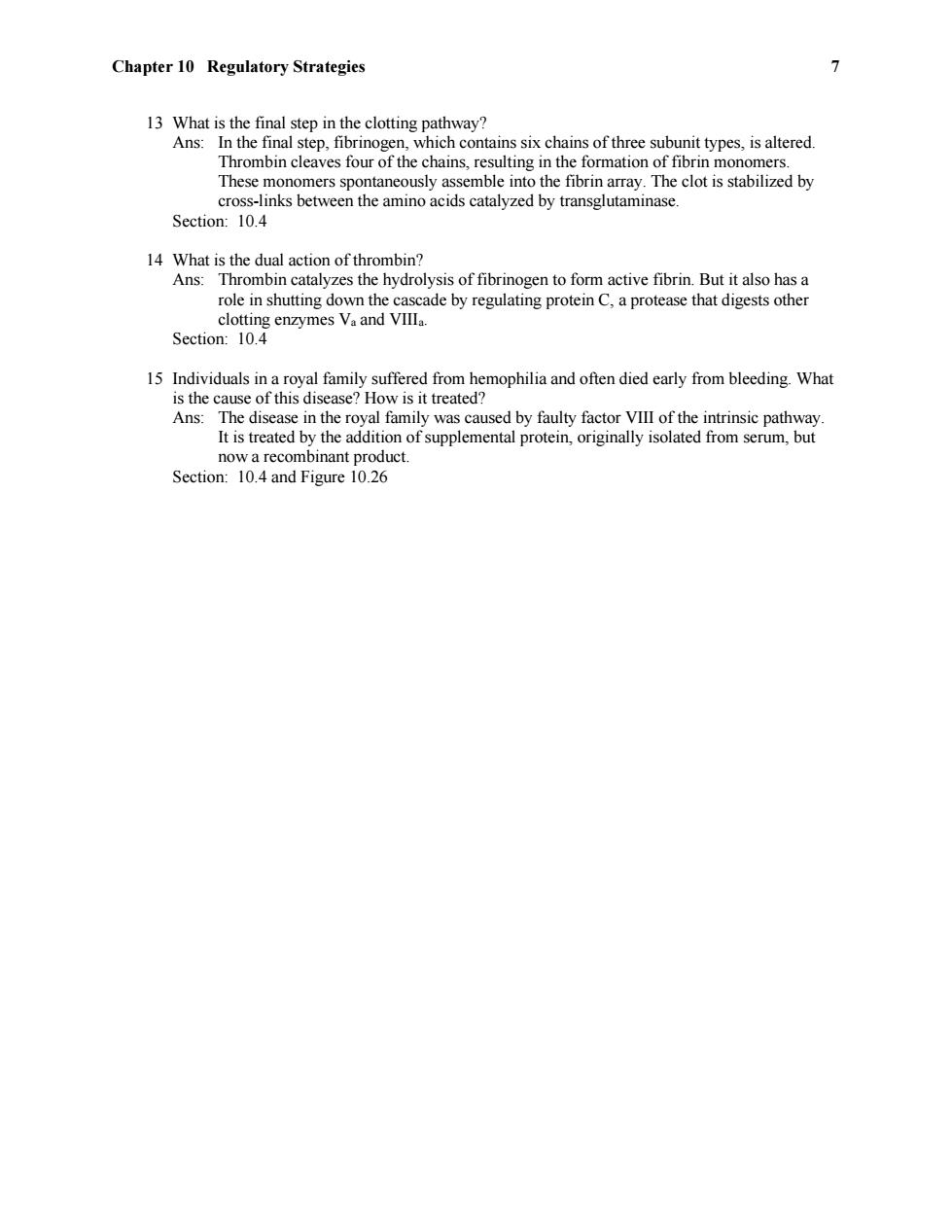
Chapter 10 Regulatory Strategies 7 13 What is the final step in the clotting pathway? Ans:In the final step,fibrinogen,which contains six chains of three subunit types,is altered. Thrombin cleaves four of the chains,resulting in the formation of fibrin monomers. These monomers spontaneously assemble into the fibrin array.The clot is stabilized by cross-links between the amino acids catalyzed by transglutaminase. Section:10.4 14 What is the dual action of thrombin? Ans:Thrombin catalyzes the hydrolysis of fibrinogen to form active fibrin.But it also has a role in shutting down the cascade by regulating protein C,a protease that digests other clotting enzymes Va and VIlIa. Section:10.4 15 Individuals in a royal family suffered from hemophilia and often died early from bleeding.What is the cause of this disease?How is it treated? Ans:The disease in the royal family was caused by faulty factor VIII of the intrinsic pathway. It is treated by the addition of supplemental protein,originally isolated from serum,but now a recombinant product. Section:10.4 and Figure 10.26
Chapter 10 Regulatory Strategies 7 13 What is the final step in the clotting pathway? Ans: In the final step, fibrinogen, which contains six chains of three subunit types, is altered. Thrombin cleaves four of the chains, resulting in the formation of fibrin monomers. These monomers spontaneously assemble into the fibrin array. The clot is stabilized by cross-links between the amino acids catalyzed by transglutaminase. Section: 10.4 14 What is the dual action of thrombin? Ans: Thrombin catalyzes the hydrolysis of fibrinogen to form active fibrin. But it also has a role in shutting down the cascade by regulating protein C, a protease that digests other clotting enzymes Va and VIIIa. Section: 10.4 15 Individuals in a royal family suffered from hemophilia and often died early from bleeding. What is the cause of this disease? How is it treated? Ans: The disease in the royal family was caused by faulty factor VIII of the intrinsic pathway. It is treated by the addition of supplemental protein, originally isolated from serum, but now a recombinant product. Section: 10.4 and Figure 10.26